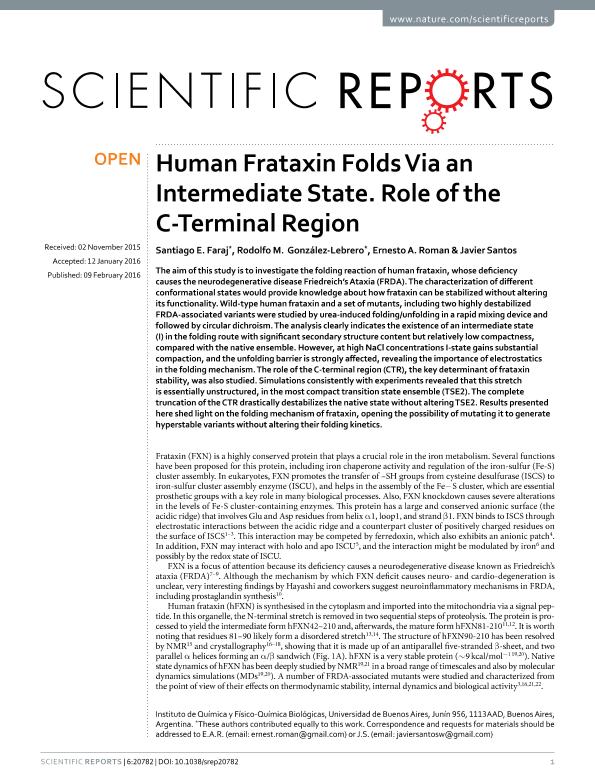Artículo
Human Frataxin Folds Via an Intermediate State. Role of the C-Terminal Region
Fecha de publicación:
02/2016
Editorial:
Nature Publishing Group
Revista:
Scientific Reports
ISSN:
2045-2322
Idioma:
Inglés
Tipo de recurso:
Artículo publicado
Clasificación temática:
Resumen
The aim of this study is to investigate the folding reaction of human frataxin, whose deficiency causes the neurodegenerative disease Friedreich’s Ataxia (FRDA). The characterization of different conformational states would provide knowledge about how frataxin can be stabilized without altering its functionality. Wild-type human frataxin and a set of mutants, including two highly destabilized FRDA-associated variants were studied by urea-induced folding/unfolding in a rapid mixing device and followed by circular dichroism. The analysis clearly indicates the existence of an intermediate state (I) in the folding route with significant secondary structure content but relatively low compactness, compared with the native ensemble. However, at high NaCl concentrations I-state gains substantial compaction, and the unfolding barrier is strongly affected, revealing the importance of electrostatics in the folding mechanism. The role of the C-terminal region (CTR), the key determinant of frataxin stability, was also studied. Simulations consistently with experiments revealed that this stretch is essentially unstructured, in the most compact transition state ensemble (TSE2). The complete truncation of the CTR drastically destabilizes the native state without altering TSE2. Results presented here shed light on the folding mechanism of frataxin, opening the possibility of mutating it to generate hyperstable variants without altering their folding kinetics.
Palabras clave:
Frataxin
,
Folding
,
Stability
,
Kinetic
Archivos asociados
Licencia
Identificadores
Colecciones
Articulos(IQUIFIB)
Articulos de INST.DE QUIMICA Y FISICO-QUIMICA BIOLOGICAS "PROF. ALEJANDRO C. PALADINI"
Articulos de INST.DE QUIMICA Y FISICO-QUIMICA BIOLOGICAS "PROF. ALEJANDRO C. PALADINI"
Citación
Faraj, Santiago Enrique; Gonzalez-Lebrero, Rodolfo Martin; Roman, Ernesto Andres; Santos, Javier; Human Frataxin Folds Via an Intermediate State. Role of the C-Terminal Region; Nature Publishing Group; Scientific Reports; 6; 2-2016; 1-16; 20782
Compartir
Altmétricas




